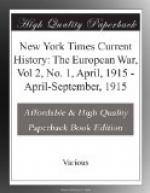Some doubt has been thrown by correspondents upon the ability of the Zeppelins to reach London from Cuxhaven, the place from which the raiders of Tuesday night appear to have started. The distance which the airships traveled, including their manoeuvres over the land, must have been quite 650 miles. This is not nearly as far as similar airships have traveled in the past. One of the Zeppelins flew from Friedrichshafen, on Lake Constance, to Berlin, a continuous flight of about 1,000 miles, in thirty-one hours. Our naval officers will also recall the occasion of the visit of the First Cruiser Squadron to Copenhagen in September, 1912, when the German passenger airship Hansa was present. The Hansa made the run from Hamburg to Copenhagen, a distance of 198 miles, in seven hours, and Count Zeppelin was on board her. Supposing an airship left Cuxhaven at noon on some day when the conditions were favorable and traveled to London, she could not get back again by noon next day if she traveled at the half-power speed which the vessels on Tuesday appear to have used. But if she did the run at full speed—that is to say, at about fifty miles an hour—she could reach London by 9 o’clock the same evening, have an hour to manoeuvre over the capital, and return by 7 o’clock next morning. With a favorable wind for her return journey, she might make an even longer stay. Given suitable conditions, therefore, as on Tuesday, there appears to be no reason why, as far as speed and fuel endurance are concerned, these vessels should not reach London from Cuxhaven.
With regard also to the amount of ammunition a Zeppelin can carry, this depends, of course, on the lifting power of the airship and the way in which it is distributed. The later Zeppelins are said to be able to carry a load of about 15,000 pounds, which is available for the crew, fuel for the engines, ballast, provisions, and spare stores, a wireless installation, and armament or ammunition. With engines of 500 horse power, something like 360 pounds of fuel is used per hour to drive them at full speed. Thus for a journey of twenty hours the vessel would need at least 7200 pounds of fuel. The necessary crew would absorb 2000 pounds more, and probably another 1500 pounds would be taken up for ballast and stores. Allowing a weight of 250 pounds for the wireless equipment, there would remain about 4000 pounds for bombs, or something less than two tons of explosives, for use against a target 458 miles from the base. This amount of ammunition could be increased proportionately as the conditions were altered by using a nearer base, or by proceeding at a slower and therefore more economical speed, &c.




